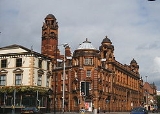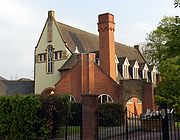
Edgar Wood
Encyclopedia
Edgar Wood was an architect who practised from Manchester
at the turn of the 20th century and gained a considerable reputation both in Britain and abroad, notably in Germany. British design was then of European significance. His work is principally domestic, but he designed several churches and small commercial buildings. He worked as an individual designer, mostly with only one assistant, and confined himself to the smaller type of building that he could control personally. Although he was active in Manchester for over twenty years, most of his work is in nearby towns, such as Rochdale
, Oldham
and Middleton
(of which he was native), and in outlying districts such as Bramhall
and Hale
. He contributed to Manchester in various ways. He was a founder of the Northern Art Workers' Guild in 1896, one of the major provincial societies within the Arts and Crafts Movement; he was president of the Manchester Society of Architects from 1911-12; and he was instrumental in saving the colonnade of Manchester's first town hall, designed by Francis Goodwin
, which stood in King Street
and was demolished c. 1911. Wood raised a public appeal and prepared a scheme for the re-erection of the colonnade in Platt Fields park
, and when this was rejected he drew up another for a site in Heaton Park
where the colonnade now stands, a magnificent Ionic wide screen and a fine parkland feature."1
The direction of Edgar's life after school was a controversial subject in the Wood household. It had been assumed by his father that Edgar would enter the family cotton business but he had different ideas. Edgar's ambition was to be an artist. The difference in opinion was finally resolved in a compromise which saw Edgar agreeing to train as an architect.
 Edgar Wood was articled to Mills and Murgatroyd, a Manchester architectural firm responsible for a number of prominent buildings in the Manchester area. Perhaps the best way to judge how Wood felt about his years as a pupil can be gleaned from his own comments in a lecture he delivered in 1900 in Birmingham
Edgar Wood was articled to Mills and Murgatroyd, a Manchester architectural firm responsible for a number of prominent buildings in the Manchester area. Perhaps the best way to judge how Wood felt about his years as a pupil can be gleaned from his own comments in a lecture he delivered in 1900 in Birmingham
, "My earliest architectural years were passed in an atmosphere where beautiful creative powers as applied to building, and life in design generally, were drowned in the solemnity of commerce, tracing paper and the checking of quantities."
Edgar passed the RIBA qualifying examinations and became an Associate in 1885. He set up his own office in Middleton and his first commission seems to have been for a shelter and drinking fountain (below) paid for by his stepmother and placed in the Middleton market square to commemorate Queen Victoria's Jubilee.
By 1892, it appears that his practice was flourishing and he moved into new premises at 78 Cross Street in the heart of Manchester. Ever the artist he would arrive at work wearing a large black cloak, lined with red silk, a flat, broad-brimmed hat and brandishing a silver handled cane. He said, "If an architect is not allowed to advertise his name he must advertise his personality."
John H. G. Archer says of Wood that, "Architecturally, Wood's sympathy lay with the progressive movement of the day, represented first by William Morris and the Arts and Crafts Movement". Wood was a founder member of the Northern Art Worker's Guild and became its Master in 1897. Wood practised in various crafts and he designed furniture, jewellery and metalwork. Archer adds, "In Wood's architecture the influences of both the Arts and Crafts Movement and Art Nouveau are clearly apparent, the former by his revival of the vernacular traditions of Lancashire and West Riding buildings, and the latter by his use of elongated forms and interwoven motifs."
Manchester
Manchester is a city and metropolitan borough in Greater Manchester, England. According to the Office for National Statistics, the 2010 mid-year population estimate for Manchester was 498,800. Manchester lies within one of the UK's largest metropolitan areas, the metropolitan county of Greater...
at the turn of the 20th century and gained a considerable reputation both in Britain and abroad, notably in Germany. British design was then of European significance. His work is principally domestic, but he designed several churches and small commercial buildings. He worked as an individual designer, mostly with only one assistant, and confined himself to the smaller type of building that he could control personally. Although he was active in Manchester for over twenty years, most of his work is in nearby towns, such as Rochdale
Rochdale
Rochdale is a large market town in Greater Manchester, England. It lies amongst the foothills of the Pennines on the River Roch, north-northwest of Oldham, and north-northeast of the city of Manchester. Rochdale is surrounded by several smaller settlements which together form the Metropolitan...
, Oldham
Oldham
Oldham is a large town in Greater Manchester, England. It lies amid the Pennines on elevated ground between the rivers Irk and Medlock, south-southeast of Rochdale, and northeast of the city of Manchester...
and Middleton
Middleton, Greater Manchester
Middleton is a town within the Metropolitan Borough of Rochdale, in Greater Manchester, England. It stands on the River Irk, south-southwest of Rochdale, and north-northeast of the city of Manchester...
(of which he was native), and in outlying districts such as Bramhall
Bramhall
Bramhall is a suburb of the Metropolitan Borough of Stockport, in Greater Manchester, England. It has a population of about 25,500.Research by the University of Sheffield has placed Bramhall as the "least lonely" place in Britain. Bramhall is also regarded as an affluent area where most residents...
and Hale
Hale, Greater Manchester
Hale is a village and electoral ward within the Metropolitan Borough of Trafford, in Greater Manchester, England. It is contiguous with the southeast of Altrincham, approximately southwest of the city of Manchester....
. He contributed to Manchester in various ways. He was a founder of the Northern Art Workers' Guild in 1896, one of the major provincial societies within the Arts and Crafts Movement; he was president of the Manchester Society of Architects from 1911-12; and he was instrumental in saving the colonnade of Manchester's first town hall, designed by Francis Goodwin
Francis Goodwin
Francis Goodwin was an English architect, best known for his many provincial churches in the Gothic revival style, civic buildings such as the first Manchester Town Hall and Macclesfield town hall , plus country houses such as Lissadell House, County Sligo .Goodwin was born at King's Lynn,...
, which stood in King Street
King Street, Manchester
King Street is one of the most important thoroughfares of the city of Manchester, England. Once the centre of the north-west banking industry it is now predominantly an affluent shopping area.-History:...
and was demolished c. 1911. Wood raised a public appeal and prepared a scheme for the re-erection of the colonnade in Platt Fields park
Platt Fields Park
Platt Fields Park is a park off Wilmslow Road in Fallowfield, Manchester, England. It is home to Platt Hall, and was originally known as the Platt Estate or the Platt Hall Estate...
, and when this was rejected he drew up another for a site in Heaton Park
Heaton Park
Heaton Park, covering an area variously reported as , 247 hectares, , over and is the biggest park in Greater Manchester, England and one of the biggest municipal parks in Europe. The park comprises the grounds of a Grade I listed, neoclassical 18th century country house, Heaton Hall...
where the colonnade now stands, a magnificent Ionic wide screen and a fine parkland feature."1
Early years
Edgar Wood was born on 17th May 1860. He was the sixth of eight children born to Thomas Broadbent Wood and Mary Sykes. Only three of the children lived to adulthood. The family lived in Middleton and Wood's father was a mill owner, a Unitarian, a Liberal and had a reputation as a strict disciplinarian. Edgar was educated at the local Queen Elizabeth Grammar School.The direction of Edgar's life after school was a controversial subject in the Wood household. It had been assumed by his father that Edgar would enter the family cotton business but he had different ideas. Edgar's ambition was to be an artist. The difference in opinion was finally resolved in a compromise which saw Edgar agreeing to train as an architect.
Edgar Wood - architect

Birmingham
Birmingham is a city and metropolitan borough in the West Midlands of England. It is the most populous British city outside the capital London, with a population of 1,036,900 , and lies at the heart of the West Midlands conurbation, the second most populous urban area in the United Kingdom with a...
, "My earliest architectural years were passed in an atmosphere where beautiful creative powers as applied to building, and life in design generally, were drowned in the solemnity of commerce, tracing paper and the checking of quantities."
Edgar passed the RIBA qualifying examinations and became an Associate in 1885. He set up his own office in Middleton and his first commission seems to have been for a shelter and drinking fountain (below) paid for by his stepmother and placed in the Middleton market square to commemorate Queen Victoria's Jubilee.
By 1892, it appears that his practice was flourishing and he moved into new premises at 78 Cross Street in the heart of Manchester. Ever the artist he would arrive at work wearing a large black cloak, lined with red silk, a flat, broad-brimmed hat and brandishing a silver handled cane. He said, "If an architect is not allowed to advertise his name he must advertise his personality."
John H. G. Archer says of Wood that, "Architecturally, Wood's sympathy lay with the progressive movement of the day, represented first by William Morris and the Arts and Crafts Movement". Wood was a founder member of the Northern Art Worker's Guild and became its Master in 1897. Wood practised in various crafts and he designed furniture, jewellery and metalwork. Archer adds, "In Wood's architecture the influences of both the Arts and Crafts Movement and Art Nouveau are clearly apparent, the former by his revival of the vernacular traditions of Lancashire and West Riding buildings, and the latter by his use of elongated forms and interwoven motifs."

